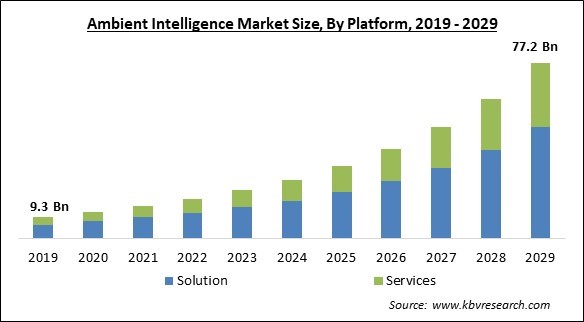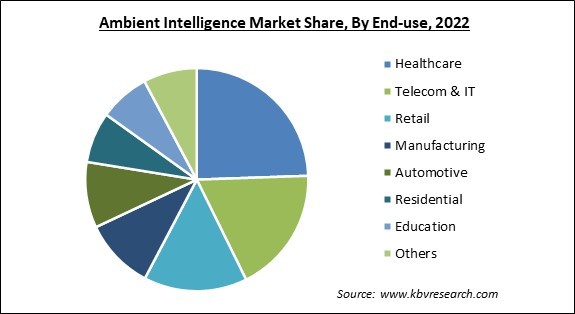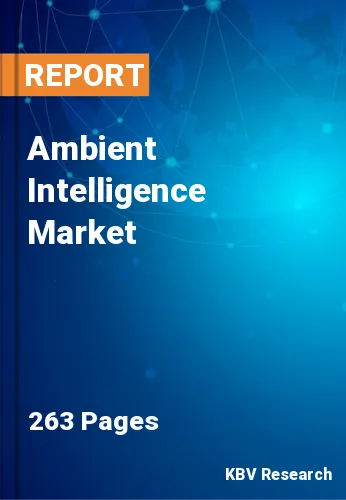The Global Ambient Intelligence Market size is expected to reach $77.2 billion by 2029, rising at a market growth of 24.1% CAGR during the forecast period.
The term "ambient intelligence" (AmI) in computing describes electronic settings that are perceptive to human presence and reacting to it. Ubiquitous communication, ubiquitous computing, and intelligent user interfaces are the three main technologies on which Ambient Intelligence is built. Some major drivers for expanding the ambient intelligence market size include embeddedness, context awareness, transparency, and machine learning.

Ambient Intelligence is a term used to describe a digital setting that proactively and intelligently assists users in their daily activities. The idea of Ambient Intelligence offers a vision of the information society where a focus is placed on improved user-friendliness, more effective service assistance, user empowerment, and support for human relationships. The environment may become intelligent enough to recognize human movement and react to its changing health requirements due to passive, contactless sensors integrated into it.
Smart homes can use ambient intelligence in various ways, which has become the primary driver of market expansion. Ambient Intelligence technology assists in improving performance and efficiency and restoring human-machine contact. For instance, Ambient Intelligence enabled systems to recognize when a user is absent, allowing power savings when unused.
The rise in smart cities & smart spaces due to the increased global population has increased energy and cost efficiency, which in turn has increased the market for ambient intelligence. In addition, the market is growing due to rising investments in ambient intelligence by developing countries and rising consumer adoption of nanotechnology, smart technology, and autonomous vehicles.
The COVID-19 pandemic's appearance had a beneficial impact on the market for ambient intelligence and ambient computing vendors. The worldwide lockdown and moving to a lifestyle of working from home are mostly responsible for it. The trend is still in place as businesses have expanded their work-from-home policies, people are still working from home, and they are looking for cutting-edge digital solutions to streamline their working lives. Additionally, the COVID-19 pandemic has altered consumer expectations as the market for ambient intelligence is being driven by both individual and industrial users leveraging IoT sensors to meet their exponentially growing need for digital experiences. Since COVID-19 widespread has spread widely, the ambient intelligence market has reaped tremendous benefits.
Unlike conventional electrical equipment, smart devices may connect, share, and communicate with users and other smart devices nearby. The rise in smart cities or smart spaces for cost- and energy-effectiveness has been accompanied by a growth in the global population, increasing the adoption of smart houses. Voice interaction, podcast streaming, music playback, playing audiobooks, delivering real-time information, and other uses are just a few ambient intelligence applications in smart homes. This is anticipated to fuel the market's revenue growth during the period. Due to these benefits, the adoption of smart devices is predicted to increase, thereby supporting the growth of the ambient intelligence market.
Many of these crucial aspects of the customer experience, including the lack of fitting rooms, interactions with store employees, the acceptance of cash purchases, and in-store product testing, were put to the ultimate test during the Covid-19 pandemic and the ensuing social isolation. As a result, Radio-frequency identification (RFID) tags are now a key component of automated in-store checkout systems. RFID tags are very small metal strips that transmit data about the object to which they are attached using radio waves, as their name suggests. Due to the risk of virus transmission, contactless commerce has become more popular. This increased the need for Ambient Intelligence in the retail sector and helped the market grow.
The ambient intelligence market's revenue expansion is anticipated to be somewhat constrained over the forecast year by several important variables, including security, privacy, and identity concerns. Data theft is rising, and privacy & security issues are becoming more common in the virtual world. It would be challenging to build a legal framework or pass legislation that can guarantee users' data will be kept secure, but there have been some efforts made by governments in various nations to provide guidelines for safeguarding any privacy. The task would be to develop a technologically sophisticated system that can be used to verify the users' identities and enable auto-erase features to secure the users' personal data from malware.
By Platform, the ambient intelligence market is segmented into solution and services. In 2022, the solution segment held the highest revenue share in the ambient intelligence market. The increased development of smart gadgets to offer a better virtual experience for everyday chores is what is driving the category growth. Hardware and software are both included in the solution section. Hardware refers to the presence of particular sensors and parts in the device, whilst software enables pairing and control between different smart devices.

On the basis of end-use, the ambient intelligence market is bifurcated into IT & telecom, healthcare, retail, residential, manufacturing, automotive, education and others. The retail segment acquired a substantial revenue share in the ambient intelligence market in 2022. Businesses tag various items and keep track of them during the manufacturing and commercialization processes utilizing RFID sensors, which are employed in Ambient Intelligence technology. The sensor makes it possible to trace a product's journey from production to consumer and helps gather useful data that the producer can use to respond to market failure and demand for a product.
Based on technology, the ambient intelligence market is fragmented into Bluetooth Low Energy, RFID, ambient light sensor, software agents, affective computing, biometrics and others. The RFID segment garnered a significant revenue share in the ambient intelligence market in 2022. RFID is being utilized more frequently in supply chain management to monitor the flow of commodities from manufacture to delivery. As a result, businesses may establish more cost-effective, responsive, and efficient supply chains, increasing customer satisfaction while lowering expenses by integrating RFID into ambient computing systems.
| Report Attribute | Details |
|---|---|
| Market size value in 2022 | USD 17.4 Billion |
| Market size forecast in 2029 | USD 77.2 Billion |
| Base Year | 2022 |
| Historical Period | 2019 to 2021 |
| Forecast Period | 2023 to 2029 |
| Revenue Growth Rate | CAGR of 24.1% from 2023 to 2029 |
| Number of Pages | 263 |
| Number of Table | 430 |
| Report coverage | Market Trends, Revenue Estimation and Forecast, Segmentation Analysis, Regional and Country Breakdown, Companies Strategic Developments, Company Profiling |
| Segments covered | Product, Test Type, Application, End User, Region |
| Country scope | US, Canada, Mexico, Germany, UK, France, Russia, Spain, Italy, China, Japan, India, South Korea, Singapore, Malaysia, Brazil, Argentina, UAE, Saudi Arabia, South Africa, Nigeria |
| Growth Drivers |
|
| Restraints |
|
Region wise, the ambient intelligence market is analysed across North America, Europe, Asia Pacific and LAMEA. The North America region led the ambient intelligence market by generating the highest revenue share in 2022. This results from the industry's presence of significant companies, rapid adoption of cutting-edge technology, and high degrees of digitalization throughout many industries. The move toward automation has opened up significant economic prospects for US corporations and their competitors. In addition, the COVID-19 pandemic has increased awareness of and use of ambient intelligence in the US, where it is being utilized to increase efficiency, support the healthcare sector, and decrease manual labor.
Free Valuable Insights: Global Ambient Intelligence Market size to reach USD 77.2 Billion by 2029
The market research report covers the analysis of key stakeholders of the market. Key companies profiled in the report include Johnson Controls International PLC, Siemens AG, Honeywell International, Inc. (Honeywell Commercial Security), Nuance Communications, Inc. (Microsoft Corporation), Zippin, Ambient AI, Inc., Noonum, LLC, Infosys Limited, Eleos Health, Inc. and Eyeris Technologies, Inc.
By Platform
By End Use
By Technology
By Geography
The Market size is projected to reach USD 77.2 billion by 2029.
Rising demand for contactless shopping are driving the market in coming years, however, Security and privacy concerns along with identity issues restraints the growth of the market.
Johnson Controls International PLC, Siemens AG, Honeywell International, Inc. (Honeywell Commercial Security), Nuance Communications, Inc. (Microsoft Corporation), Zippin, Ambient AI, Inc., Noonum, LLC, Infosys Limited, Eleos Health, Inc. and Eyeris Technologies, Inc.
The Healthcare market is leading the segment in the Market by End-use in 2022; thereby, achieving a market value of $16.6 billion by 2029.
The North America market dominated the Market by Region in 2022; thereby, achieving a market value of $27.0 billion by 2029.
Our team of dedicated experts can provide you with attractive expansion opportunities for your business.

